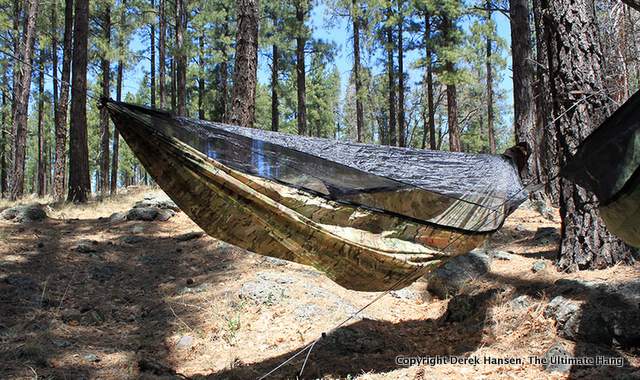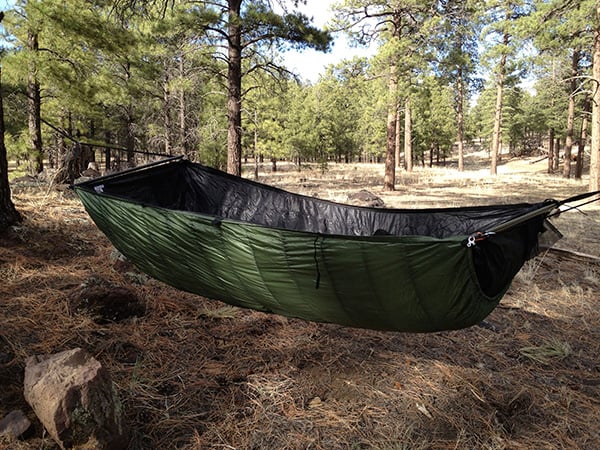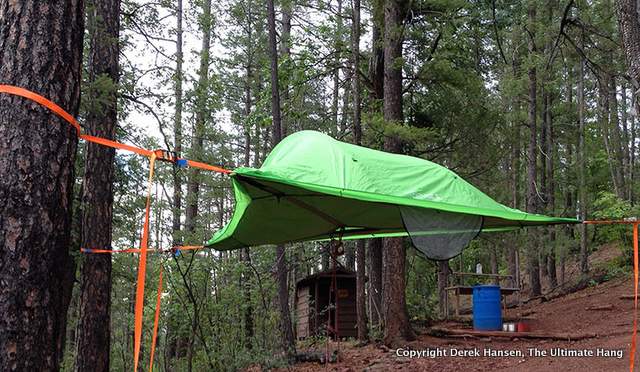
Single. Double. Triple. Bridge. Gathered end. Spreader bar. With all the different styles and designs of hammocks available, choosing the right one can be confusing, particularly if you’re intending that hammock for a specific purpose, such as a thru-hike on the AT. I’ve tested and seen just about every type of hammock and I hope this quick overview will help you satisfactorily sift through the silt.
Hammock Styles
While there are many styles, designs, and options that differentiate hammocks, I first classify hammocks into two main styles: open and jungle.

An open hammock is your basic, everyday style and refers to any design that has no bug netting and is open to its surroundings. A jungle hammock, in contrast, is any design that has an integrated, encapsulating bug net.

Hammock Designs
In terms of hammock design, there are a few common categories such as gathered-end, bridge, spreader bar, single-point, multi-point, and hybrid. Hammock designs can be either open or jungle style. For example, you can have an open gathered-end hammock or a jungle-style gathered-end hammock. There are open bridge hammocks and jungle bridge hammocks as well as multi-point jungle hammocks. Open hammocks are more common indoors and for basic recreation at a city park or a backyard. Jungle hammocks are more convenient and prevalent for camping.
A gathered-end design is the most common and is often identified by big brands such as ENO, Grand Trunk, and Kammok. A gathered-end design is about as simple as hammocks get, with a rectangular shaped fabric bunched up along the short ends and hung between two anchor points.

A gathered-end design can defy logic in how to properly hang and lay in one, but they are so simple to use and inexpensive to buy that most folks ignore the learning curve and use them just about any way they want. When properly hung, a gathered-end hammock has a relaxed, catenary curve that allows the occupant to lay across the fabric in a recumbent, ergonomic lay. The center of gravity is low, making this a very secure, non-tippy design.
The terms “single,” “double,” and even “triple” are most often associated with gathered-end hammocks and refer not to occupancy but width. Nearly all brands who sell “single” and “double” variations use the same fabric and construction techniques so each hammock has the same weight limit.
Spreader bar hammocks are often seen on picture postcards showing exotic hotels or secluded tropical beaches and the obligatory swimsuit model. The identifying characteristic is a pole, or wooden bar, that spreads the hammock out on the short ends to flatten the fabric out.
Spreader bars raise the center of gravity, making this design very tippy. Spreader bar hammocks tend to be heavier and bulkier designs because of the added hardware and accessories required. A popular jungle style is the Lawson Blue Ridge hammock.

A bridge design is a more modern entrant into the hammock universe. It also uses spreader bars, but the hammock is engineered like a suspension bridge (hence the name) allowing the occupant to have a true head-to-foot flat lay while the fabric curves above them. This hammock is more stable than a spreader bar hammock but can be a little wobbly.
Depending on the catenary cuts on the fabric and the length of the spreader bars, a bridge design can look a lot like a barrel cut in half. This design can contribute to a slight shoulder squeeze. Like spreader bar hammocks, bridge designs are typically heavier than gathered-end designs although there are a few ways to get to a “trail” weight by substituting multi-use items like trekking poles for the spreader bars.

Single-point designs, as the name suggests, are hung from a single overhead anchor point. Portaledges, aerial yoga hammocks, and bat hammocks all fit into this category. Single-point hammocks require a little more engineering to not only reinforce the anchor point but to allow enough room for the occupant and provide enough stability during movement.

Multi-point designs have become more popular with brands like Tentsile firing the imagination. Multi-point hammocks often span large spaces and use three or more anchor points to create a platform for two or more occupants. Multi-point hammocks tend to be the heaviest and most robust of all designs due to their increase load capacity and hanging requirements.
Hybrid designs include the rest of the wild and wonderful variations but are typically a smaller subset of other design categories. The Clark Vertex two-person hammock is a popular variation, but we’ve recently seen hot tub hammocks and alpine convertible hammocks as well.
Buying Advice
If you’re looking for a hammock, first ask yourself how you intend to use it, most of the time.
• For all-around, everyday use — In most cases, get an open, gathered-end design. A spreader bar hammock can look nostalgic, but can often be more tippy than useful.
• For 3-season car camping — Any design would work well if weight and bulk are of little concern, but be mindful about multi-point hammocks that may not work in most state parks.
• For backpacking and thru-hiking — Focus on gathered-end, jungle style hammocks. These hammocks will be the lightest and most convenient for every-day camping use.
- Hennessy Hammock Expedition Asym Zip Hammock
- ENO OneLink Hammock Shelter System with DoubleNest Hammock
About the Author
Derek Hansen is a lightweight backpacker, former Scoutmaster, and “hammock enthusiast” who enjoyed his first hammock hang at age 14 at the BSA Beaver High Adventure base in Utah. He is the author and illustrator of The Ultimate Hang: an illustrated guide to hammock camping.
SectionHiker is reader-supported. We only make money if you purchase a product through our affiliate links. Help us continue to test and write unsponsored and independent gear reviews, beginner FAQs, and free hiking guides. SectionHiker.com Backpacking Gear Reviews and FAQs
SectionHiker.com Backpacking Gear Reviews and FAQs
Pretty sure Derek didn’t write this, not in 2023 anyway. Lots of useful info here right next to some bad info and some outright falsehoods. Perhaps some of these things are related to the lack of depth with respect to offerings, and therefore, the lack of links to those products.
Derek did write this actually. You can ask him.